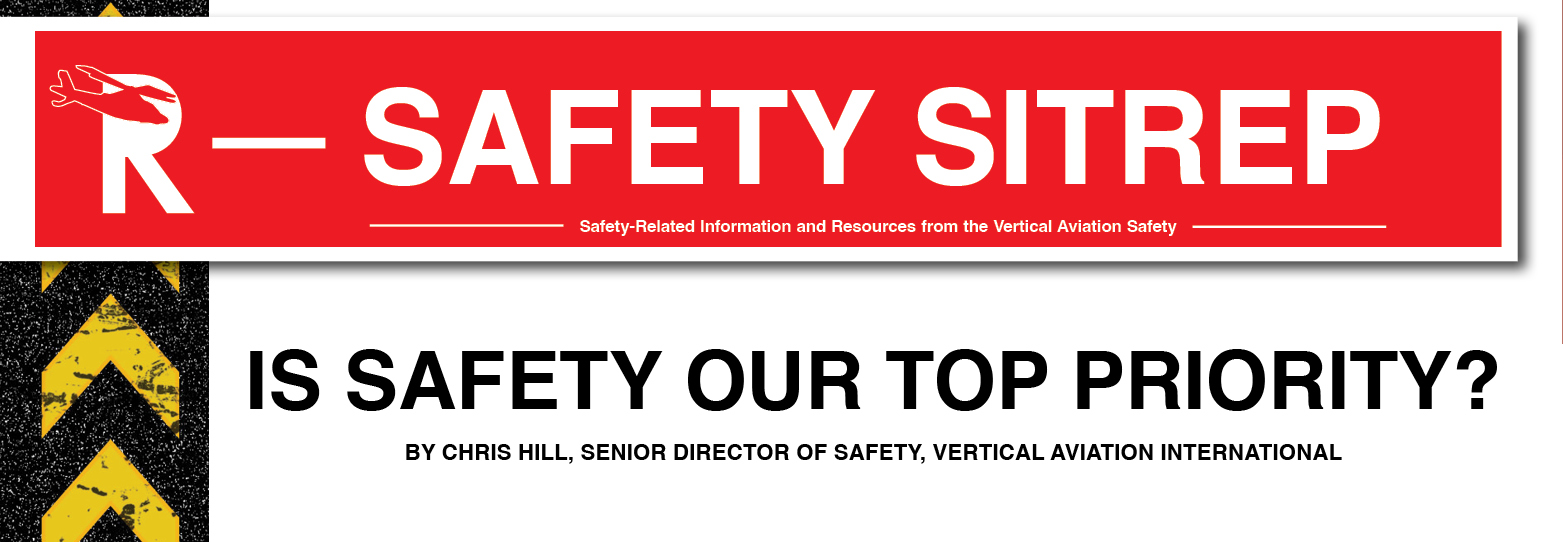|
Jul
27
2025
|
|
Posted 138 days ago ago by Admin
|
|

By Chris Hill, senior director of safety, Vertical Aviation International
Safety First! It's a common battle cry. Many operators proudly claim that safety is their "top priority," particularly in the wake of a high-profile accident. The not-so-little secret is: It's not. Come on, we know it's not.
Turn the cameras off and ask an experienced director of ops, director of maintenance, or chief pilot if safety is honestly the top priority in their organization. The director of safety would likely give you a polite chuckle and perhaps even a reference to Mike Rowe, host of the hit television series "Dirty Jobs" In a 2008 TED Talk and several similar discussions, Rowe asks us to consider accepting a safety-third mentality. He admits, "I value my safety on these crazy jobs as much as the people that I am working with. The ones who really get it done; they're not out there talking about safety first. They know that other things come first. The business of doing the work comes first. The business of getting it done."
Successful business owners and CEOs understand that sustaining a profitable business is always Priority One. They must manage and accept some residual risk to remain a viable organization. Failure to prioritize core aviation business objectives of turning wrenches and flying missions and instead fixating on eliminating all risk is an unsustainable business model. There is no way to eliminate all risks without locking the hangar doors and grounding the aircraft.
Having bluntly acknowledged the reality of the inherent risk in aviation operations, how do we reconcile organizational priorities while demonstrating a sincere commitment to safety? We can start by looking at safety from a whole new angle.
Safety as a Core Value
Dr. David Michaels, the former head of the U.S. Occupational Safety and Health Administration (OSHA), offers some compelling thoughts regarding how one should view safety, stating, "Today and every day in the future, corporate leaders need to reassess what safety means and how their company can achieve it. They need to recognize that safety is a value proposition, that safety management and operational excellence are inextricably linked." When referring to CEOs who take their safety commitments seriously, Michaels continues, "…my bet is you won't hear the same old tired line that safety is a priority. They understand that safety is not a priority — it is an essential precondition of their work. It is a fundamental component of their operating culture. Safety, ultimately, is at the core of what they do."
Safety as an Imperative
Retired Army Brigadier General Timothy Edens echoed this core value during his tenure as commanding general of the U.S. Army's Combat Readiness and Safety Center. He repeatedly emphasized that safety was an imperative to mission success, not just a priority. Edens clarified, "…priorities are dynamic and vulnerable. They can be watered down or traded away. Successful operators, the ones who get it, consistently proved that safety is tightly woven into the very fabric of every organizational activity."
Those who apply a similar mindset understand that no matter how we choose to characterize our safety objectives or priorities what matters most is consistent decision-making, actions, and behaviors that demonstrate an uncompromising commitment to safety from the top-down and the bottom-up of every organization. In other words, they walk the talk every day, and we can do the same.
Minimum vs. Maximum Effort
Let's assume we are ready to explore ways to elevate safety in our operations. Are we doing our best to prevent accidents for the right reasons, or are we in a race to the bottom, seeking to meet the minimum standards – to appease government regulators, insurance underwriters, and contract managers? Do we claim to be so busy complying with the minimums that we fail to see the ROI in doing more? With such demanding minimum standards, how can one achieve maximum effort?
If we accept our status quo with a dismissive "we've never had an accident" excuse, what must happen for us to change – an unthinkable tragedy? The nasty event our flawed logic assumes can only happen to others, resulting in loss of life, aircraft, insurance, trust, reputation, customers, contracts, or the entire business. Try assigning value to all of that!
If we invest the time and resources to stock a better war chest, what will we fill it with to help prevent a preventable accident? Where does one begin? What does "maximum effort" look like when we imagine the unimaginable, and is it necessary? Let's acknowledge that merely meeting the minimum standard falls short, while achieving maximum effort may also be unrealistic. Instead, let's aim to improve a little each day. That's an achievable goal.
Who's in?
READ MORE ROTOR PRO: https://justhelicopters.com/Magazine
WATCH ROTOR PRO YOUTUBE CHANNEL: https://buff.ly/3Md0T3y
You can also find us on
Instagram - https://www.instagram.com/rotorpro1
Facebook - https://www.facebook.com/rotorpro1
Twitter - https://twitter.com/justhelicopters
LinkedIn - https://www.linkedin.com/company/rotorpro1